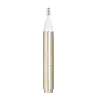What's inside
What's inside
 Key Ingredients
Key Ingredients

 Benefits
Benefits

 Concerns
Concerns

No concerns
 Ingredients Side-by-side
Ingredients Side-by-side

Water
Skin ConditioningGlycerin
HumectantButylene Glycol
HumectantEthylhexyl Palmitate
EmollientHydroxyethyl Acrylate/Sodium Acryloyldimethyl Taurate Copolymer
Emulsion StabilisingSodium Polyacrylate
AbsorbentSodium Hyaluronate
HumectantSqualane
EmollientPentylene Glycol
Skin ConditioningCaprylyl Glycol
EmollientCarnosine
Skin Conditioning1,2-Hexanediol
Skin ConditioningCaffeine
Skin ConditioningSodium Citrate
BufferingGlyceryl Acrylate/Acrylic Acid Copolymer
HumectantPolysorbate 60
EmulsifyingPhenoxyethanol
PreservativeSilica Dimethyl Silylate
EmollientPropylene Glycol
HumectantAdenosine
Skin ConditioningNeoruscogenin
Skin ConditioningSorbitan Isostearate
EmulsifyingRuscogenin
Skin ConditioningDisodium Adenosine Triphosphate
Skin ConditioningHexylene Glycol
EmulsifyingLaminaria Digitata Extract
Skin ProtectingWater, Glycerin, Butylene Glycol, Ethylhexyl Palmitate, Hydroxyethyl Acrylate/Sodium Acryloyldimethyl Taurate Copolymer, Sodium Polyacrylate, Sodium Hyaluronate, Squalane, Pentylene Glycol, Caprylyl Glycol, Carnosine, 1,2-Hexanediol, Caffeine, Sodium Citrate, Glyceryl Acrylate/Acrylic Acid Copolymer, Polysorbate 60, Phenoxyethanol, Silica Dimethyl Silylate, Propylene Glycol, Adenosine, Neoruscogenin, Sorbitan Isostearate, Ruscogenin, Disodium Adenosine Triphosphate, Hexylene Glycol, Laminaria Digitata Extract
Water
Skin ConditioningCaffeine
Skin ConditioningNiacinamide
SmoothingDimethicone
EmollientButylene Glycol
HumectantGlycereth-26
HumectantPentylene Glycol
Skin ConditioningLecithin
EmollientHydroxyethyl Acrylate/Sodium Acryloyldimethyl Taurate Copolymer
Emulsion StabilisingPhenoxyethanol
PreservativeEctoin
Skin ConditioningEscin
TonicBeta-Sitosterol
Emulsion StabilisingCopper Tripeptide-1
Skin ConditioningTaurine
BufferingO-Cymen-5-Ol
AntimicrobialPolysorbate 60
EmulsifyingSorbitan Isostearate
EmulsifyingSodium Carboxymethyl Beta-Glucan
CleansingSodium Hydroxide
BufferingLysine Hcl
Skin ConditioningCaprylyl Glycol
EmollientAlanine
MaskingArginine
MaskingHistidine Hcl
Skin ConditioningSerine
MaskingAlteromonas Ferment Extract
Skin ConditioningPhenethyl Alcohol
MaskingProline
Skin ConditioningGlutamic Acid
HumectantThreonine
Valine
MaskingLeucine
Skin ConditioningGlycine
BufferingCitric Acid
BufferingAllantoin
Skin ConditioningIsoleucine
Skin ConditioningPhenylalanine
MaskingAcetyl Hexapeptide-8
HumectantWater, Caffeine, Niacinamide, Dimethicone, Butylene Glycol, Glycereth-26, Pentylene Glycol, Lecithin, Hydroxyethyl Acrylate/Sodium Acryloyldimethyl Taurate Copolymer, Phenoxyethanol, Ectoin, Escin, Beta-Sitosterol, Copper Tripeptide-1, Taurine, O-Cymen-5-Ol, Polysorbate 60, Sorbitan Isostearate, Sodium Carboxymethyl Beta-Glucan, Sodium Hydroxide, Lysine Hcl, Caprylyl Glycol, Alanine, Arginine, Histidine Hcl, Serine, Alteromonas Ferment Extract, Phenethyl Alcohol, Proline, Glutamic Acid, Threonine, Valine, Leucine, Glycine, Citric Acid, Allantoin, Isoleucine, Phenylalanine, Acetyl Hexapeptide-8
Ingredients Explained
These ingredients are found in both products.
Ingredients higher up in an ingredient list are typically present in a larger amount.
Butylene Glycol (or BG) is used within cosmetic products for a few different reasons:
Overall, Butylene Glycol is a safe and well-rounded ingredient that works well with other ingredients.
Though this ingredient works well with most skin types, some people with sensitive skin may experience a reaction such as allergic rashes, closed comedones, or itchiness.
Learn more about Butylene GlycolCaffeine is most associated with coffee, tea, and cacao. In skincare, it helps with calming inflammation and is rich in antioxidants.
While caffeine is used to treat cellulite and and dark circles, further studies are needed to prove this. It has been believed to help with these skin conditions due to its ability to dilate blood vessels and increase blood flow.
Some studies are looking into caffeine's ability to protect against UV rays.
Learn more about CaffeineCaprylyl Glycol is a humectant and emollient, meaning it attracts and preserves moisture.
It is a common ingredient in many products, especially those designed to hydrate skin. The primary benefits are retaining moisture, skin softening, and promoting a healthy skin barrier.
Though Caprylyl Glycol is an alcohol derived from fatty acids, it is not the kind that can dry out skin.
This ingredient is also used as a preservative to extend the life of products. It has slight antimicrobial properties.
Learn more about Caprylyl GlycolThis is a synthetic polymer. It helps improve the texture of products by adding thickness and gel-like feel.
It is also an emulsifer, meaning it prevents ingredients such as oil and water from separating. It also helps evenly disperse other ingredients.
Pentylene glycol is typically used within a product to thicken it. It also adds a smooth, soft, and moisturizing feel to the product. It is naturally found in plants such as sugar beets.
The hydrophilic trait of Pentylene Glycol makes it a humectant. As a humectant, Pentylene Glycol helps draw moisture from the air to your skin. This can help keep your skin hydrated.
This property also makes Pentylene Glycol a great texture enhancer. It can also help thicken or stabilize a product.
Pentylene Glycol also acts as a mild preservative and helps to keep a product microbe-free.
Some people may experience mild eye and skin irritation from Pentylene Glycol. We always recommend speaking with a professional about using this ingredient in your routine.
Pentylene Glycol has a low molecular weight and is part of the 1,2-glycol family.
Learn more about Pentylene GlycolPhenoxyethanol is a preservative that has germicide, antimicrobial, and aromatic properties. Studies show that phenoxyethanol can prevent microbial growth. By itself, it has a scent that is similar to that of a rose.
It's often used in formulations along with Caprylyl Glycol to preserve the shelf life of products.
Polysorbate 60 is used to help stabilize products. It is a surfactant and emulsifier. These properties help keep ingredients together in a product. Surfactants help reduce surface tension between ingredients with different states, such as liquids and solids. Emulsifiers help prevent oils and waters from separating.
Polysorbate 60 is sorbitol-based and created from the ethoxylation of sorbitan. Ethoxylation is a chemical reaction used to add ethylene oxide. Sorbitan is a the dehydrated version of sorbitol, a sugar found in fruits.
In this case, the 60 comes from reacting 60 units of ethylene oxide with sorbitan.
Polysorbates are commonly used in medicine and foods.
Learn more about Polysorbate 60Sorbitan Isostearate is an emulsifer and cleaning agent. It is created from isostearic acid and sorbitol.
As an emulsifier, Sorbitan Isostearate prevents oils and water from separating.
Due to its isostearic acid base, it may not be safe for Malassezia or fungal acne.
Learn more about Sorbitan IsostearateWater. It's the most common cosmetic ingredient of all. You'll usually see it at the top of ingredient lists, meaning that it makes up the largest part of the product.
So why is it so popular? Water most often acts as a solvent - this means that it helps dissolve other ingredients into the formulation.
You'll also recognize water as that liquid we all need to stay alive. If you see this, drink a glass of water. Stay hydrated!
Learn more about Water